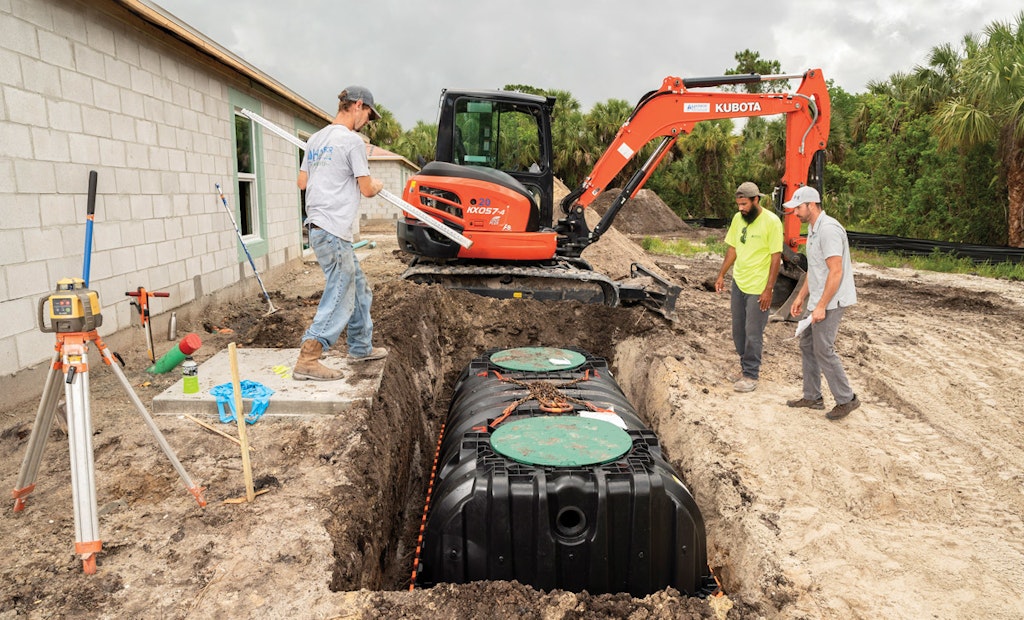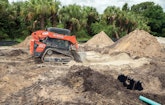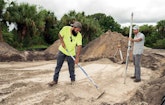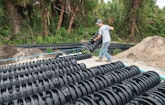
Installers Adam Neave, left, and P.J. Murphy, center, help Keith Wessner set an Infiltrator Water Technologies tank for a new system in Palm Bay, Florida. A Kubota excavator was used to dig the hole and set the tank. (Photos by Preston Mack)
Some installation businesses compete on quality. Some compete on price. Harbor Septic competes on its ability to expedite system permits in a coastal Florida county where the environment is sensitive and regulations are strict.
Managing partner Keith Wessner uses experience he gained as an onsite inspector with the state Department of Health to shave weeks off the time normally required for system permitting. That’s a blessing for homebuilders in Brevard County, which is seeing a boom in housing construction.
“I handle the permit applications,” Wessner says. “A builder will just send me a survey, a floor plan and an address and say go. I’ll do the soils, get all the paperwork together, and send it in. All the county health department has to do is review it, write the permit and sign off on it. It saves the builders two to three weeks, if not more. A lot of permits get issued without even any back and forth because they are done right from the start.”
Although just three years old, Harbor Septic, based in Melbourne, last year installed about 225 onsite systems, a number of them using aerobic treatment units to accommodate homes on beachfront lots and in a watershed where regulators are clamping down on nitrogen discharges.
Unconventional path
Wessner took an unusual route into the onsite business. He grew up in Pennsylvania, earned a bachelor’s degree in biology from Penn State, and went to work for the Department of Defense doing neurotrauma research to help with treatment of soldiers injured in the Afghanistan and Iraq wars after 9/11.
After that he worked for eight years with a pharmaceutical company, mostly involved in neuroscience drug discovery. After a merger involving the company, he took a voluntary layoff and in 2012 used his severance to move to Florida, where most of his family was living: “We moved so our kids could grow up with their grandparents, cousins, aunts and uncles.”
Looking for a job in the environmental field, he landed a position as a state health department inspector in the Brevard County office. There he learned the regulatory side of the onsite business, including site and soil profile evaluation. “It turned out to be really beneficial,” he says. “I have a huge advantage because of that. I used to do inspections and write permits, and now I’m on the other side. I’ve already installed systems that I permitted when I was with the health department.”
He had dreamed for years of starting his own business, and suddenly the onsite sector made sense. He negotiated to buy the business of a local contractor who was retiring; when the deal fell through he used the money he had set aside to buy equipment and start from scratch.
“We’re trying to expand the business to keep up with demand, while keeping a high-quality product,” Wessner says. “We pride ourselves on going above and beyond the septic code. We focus on new construction installations, as we are in a rapidly expanding market, but we also do repair installations. We’re certified with numerous ATU manufacturers for installation and for maintenance contracts.”
The workhorse equipment includes a 2012 JCB 3CX backhoe loader, 2019 and 2014 Kubota SVL75-2 track loaders, and a 2020 Kubota KX057-4 compact excavator. The truck fleet consists of a 2019 Peterbilt 348 dump truck with a HilBilt Mongoose dumpbody, 2011 and 2020 Ram flatbeds, a 2008 Ford F-450 pickup, and a 2014 Ram 1500 Ecodiesel pickup. A dump trailer (Big Tex Trailers), two bumper pull trailers (PJ Trailers and Big Tex) and a gooseneck trailer (PJ Trailers) help move equipment and material.
Fast start
In its early days, Harbor Septic bought a vacuum truck and used it full-time to pump septic tanks. Those jobs led to a goodly number of system repairs and drainfield replacements. Today the truck, a 1988 Peterbilt with a 3,150-gallon Cusco steel tank and Fruitland pump, is used mainly to pump tanks for systems the company is working on.
The focus is on new construction to meet demand from homebuilders who like the expedited permits, and on replacing drainfields, some of them under a special program in the Indian River Lagoon watershed.
“It is a pretty sensitive area,” Wessner says. “Two rivers converge there, the larger being the Indian River. Our county is long and skinny; so we border probably 70 miles of the river. It’s all low lying. A lot of streams and canal networks eventually drain into the river. There is quite a bit of nutrient loading, so there are algal blooms and poor water quality resulting from a combination of things. Septic gets blamed for everything because it’s an easy target.”
To help deal with the problem, Brevard County imposed a 0.5% sales tax to help fund a wide variety of projects to clean up the lagoon. Part of the money helps connect homes to sewers, and another part provides grants of up to $18,000 to help homeowners in high-priority areas upgrade to onsite systems with NSF 245 certified ATUs to reduce nitrogen discharges.
Curtailing nitrogen
The first phase of the program covers about 1,800 addresses, most of them on the Indian River or a tributary, usually with poor soil for septic systems. The county sent flyers to the property owners alerting them to the program, and Harbor Septic has received calls as a result.
For ATUs on those projects and on many new construction jobs, Wessner chooses Delta ECOPOD systems (Infiltrator Water Technologies) for ease of installation. He also uses Fuji Clean USA systems for their compact size and high nitrogen removal. “They have a lift mechanism that uses air from the blower to recycle water from the third chamber back to the first chamber, so it gets multiple rounds of treatment.” Wessner says.
That’s valuable on Indian River projects, where the county code specifies 65% nitrogen removal from tank effluent. The state code generally requires 24 inches of soil between the drainfield and the water table and credits 15% nitrogen removal in that soil.
“When you do a repair, depending on the year the home was built, you only need a 6- or 12-inch separation from the water table, but you don’t get that 15% credit for nitrogen reduction in the sand,” Wessner observes. “So you need 65% reduction from the ATU. Fuji Clean USA systems deliver about 75% reduction out of the tank.”
The $18,000 grant usually covers Harbor Septic’s work; some homeowners need to pay extra for an electrician to extend power to the ATU, or for sod to restore landscaping.
Wessner sees significant growth potential in Indian River projects; so far the response to the county’s solicitation has been sparse. Harbor Septic has picked up some projects as neighbors see teams at work and stop by to ask questions. More aggressive marketing in the area has been largely on hold.
“We are so overwhelmed with new construction,” Wessner says. “But it’s definitely in our plans to direct market to those people, try and educate them a little more, and let them know exactly what they’re eligible for.”
Challenging soils
Throughout the company’s territory, the water table lies generally 12 to 18 inches down. “Most everything in Brevard County is a mound,” says Wessner. “I would say maybe one or two out of 10 is a standard system.” The company uses plastic septic tanks and low-profile drainfield chamber, both from Infiltrator Water Technologies.
In the Indian River area and elsewhere, Harbor Septic more often than not encounters clay and hardpan soil layers that make for labor-intensive installations. “On most of our drainfields, we’re digging out six to eight feet to get through those layers,” Wessner says. “Then we’re trucking in, on average, eight or nine tri-axle loads of septic sand.
“If you don’t do that, you’ll have premature failures. The systems will last two years and then they’ll back up because someone left a clay layer that’s seven feet down. They’ve made a bathtub out of the drainfield. We don’t skimp on the sand. We make sure it’s dug out really well.”
Other challenges involve waterfront areas. The city of Melbourne is on the mainland, but there is extensive development on barrier islands on the Atlantic coast, including Melbourne Beach and Satellite Beach. Parts of those islands are on septic systems. Wessner notes, “Brevard County Natural Resources about four years ago enacted an ordinance that requires any new construction on the barrier islands to have an NSF 245 ATU.”
Some properties require performance-based treatment systems, which include ATUs discharging to drip irrigation. These must be designed by an engineer, and most use Fuji Clean USA ATUs. They come into play mainly on lots with short setbacks from the water. The code generally requires a 75-foot setback on new construction; a PBTS can reduce that to 65 or 50 feet. It can also enable a large home to be built on a lot otherwise too small to accommodate the flow to a conventional system.
Fixing and servicing
ATU maintenance and septic system repairs round out the company’s business. Harbor Septic handles the code-required twice-a-year maintenance on ATUs it installs. “We have about 100 systems that need two inspections per year,” Wessner says. “Most of them are new systems, so they don’t have a lot of issues yet.”
Repairs largely consist of replacing 30- to 40-year-old drainfields that have failed with age. “We dig out and remove the existing drainfield, which is usually rock and pipe, and haul that off to the landfill,” Wessner says. “Then we install fresh sand in the hole and put our chamber drainfield in. If the tank is good enough to be recertified, we will reuse it. Sometimes we replace the tank and drainfield.”
Harbor Septic has had a successful launch, and the future looks bright. “It’s a good market,” says Wessner. “We sort of timed it right for starting the business. It has worked out so far.”









